-
- PCB TYPE
- PRINTED CIRCUIT BOARD PROTOTYPE ALUMINUM PRINTED CIRCUIT BOARD R&F PCB FPC HIGH FREQUENCY PCB HIGH-TG PCB HEAVY COPPER PCB HDI PCB PCB FOR LIGHTING METAL CORE PCB
time:Jul 08. 2025, 10:51:56
In the fast - evolving landscape of electronic engineering, aluminum printed circuit boards (PCBs) have emerged as a transformative technology, bridging the gap between superior thermal management, mechanical resilience, and design flexibility. These PCBs leverage the unique properties of aluminum to address the critical challenges of modern electronics, where miniaturization, high power density, and reliability are non - negotiable. This article provides an in - depth exploration of aluminum PCBs, covering their material science, design principles, manufacturing processes, quality assurance, diverse applications, and emerging industry trends.
The Foundation of Aluminum PCBs: Material Science
Aluminum Substrate: The Core Enabler
The aluminum substrate is the defining feature of these PCBs, offering a unique combination of properties that set them apart from traditional FR4 or ceramic alternatives:
Thermal Conductivity: Aluminum's high thermal conductivity (180–210 W/mK for common alloys) allows for rapid heat dissipation, making it ideal for components that generate significant heat, such as power transistors, LEDs, and microprocessors. This property ensures that operating temperatures are kept within safe limits, preventing performance degradation and extending component lifespan.
Mechanical Strength: Aluminum alloys, particularly those in the 6xxx series (e.g., 6061, 6063), provide excellent strength - to - weight ratios. They resist bending, vibrations, and shocks, making aluminum PCBs suitable for harsh environments ranging from automotive engine bays to industrial machinery.
Formability and Cost - Effectiveness: Aluminum's malleability enables the creation of complex shapes and thin profiles, accommodating the compact designs demanded by modern electronics. Additionally, it offers a cost - effective solution compared to exotic materials like copper or ceramic, without compromising on performance.
Dielectric Layers: Balancing Insulation and Heat Transfer
The dielectric layer in aluminum PCBs serves two critical functions: electrical insulation between copper layers and facilitation of heat transfer to the aluminum substrate. The choice of dielectric material depends on the application's requirements:
Ceramic - Filled Epoxies: These materials strike a balance between thermal conductivity (1.5–2.5 W/mK) and electrical insulation, making them suitable for most commercial applications. They are cost - effective and widely used in LED lighting, consumer electronics, and industrial controls.
Polyimide Dielectrics: Renowned for their high - temperature resistance (up to 250°C) and low dielectric loss, polyimide dielectrics are preferred in demanding environments such as aerospace avionics, high - power inverters, and automotive electronics exposed to extreme temperatures.
Copper Layers and Surface Finishes
Copper, with its low electrical resistance, forms the conductive layers of aluminum PCBs:
Copper Foil Selection: Thickness varies based on current - carrying needs, with thinner foils (1–2 oz) for signal traces and thicker foils (3–4 oz) for power paths to minimize voltage drops and heat generation.
Surface Finishes:
ENIG (Electroless Nickel Immersion Gold): Provides a smooth, corrosion - resistant surface ideal for fine - pitch components and high - reliability applications like medical devices and aerospace electronics.
OSP (Organic Solderability Preservative): A thin, eco - friendly coating that protects copper from oxidation, suitable for lead - free soldering in cost - sensitive consumer electronics.
HASL (Hot Air Solder Leveling): A traditional finish that ensures excellent solderability for through - hole components, commonly used in industrial and automotive PCBs.
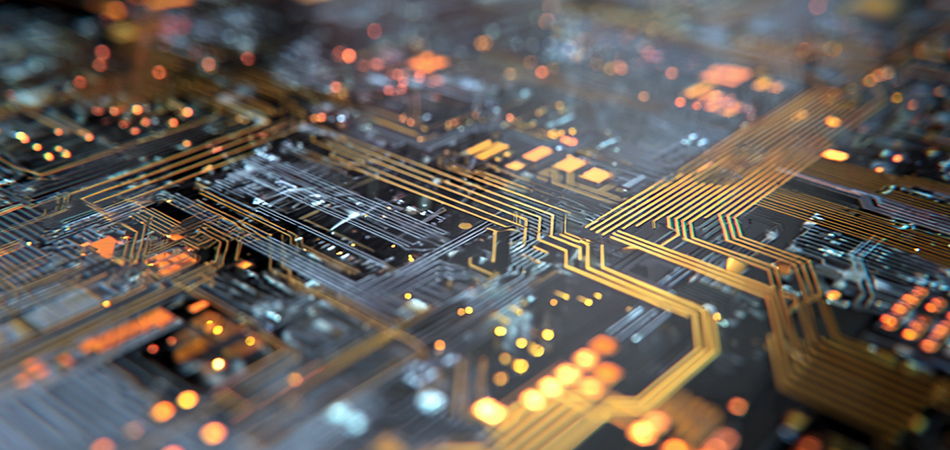
Design Principles for Aluminum PCBs
Thermal Management: The Critical Factor
Effective heat dissipation is the cornerstone of aluminum PCB design, involving strategic component placement and thermal pathway optimization:
Component Placement: Heat - generating components are positioned directly over the aluminum substrate on the top layer to maximize heat transfer. High - power devices like MOSFETs or LEDs should be spaced to avoid heat accumulation, with thermal vias (through - holes connecting copper layers to the substrate) placed in a grid pattern around them to create direct thermal pathways.
Heat Sink Integration: For applications requiring enhanced thermal performance, the aluminum substrate can be bonded to external heat sinks or thermal pads. This is particularly important in high - power LED lighting or server power supplies, where the substrate acts as a heat spreader, distributing heat to the sink and maintaining component temperatures within operational limits.
Electrical Design: Signal Integrity and Power Distribution
Signal Routing: High - speed signals on the top layer require controlled impedance routing to maintain integrity, with traces spaced to prevent crosstalk. The bottom layer often serves as a solid ground plane, reducing electromagnetic interference (EMI) and providing a stable reference for signal transmission.
Power Distribution: Robust power traces on both layers ensure efficient current flow, with the bottom layer typically used for high - current paths. Decoupling capacitors are placed close to power pins on the top layer to stabilize voltage supply and reduce switching noise in power - intensive circuits.
Mechanical Design: Durability and Form Factor
Substrate Thickness: Thinner substrates (0.8–1.6mm) are preferred for portable devices to minimize weight and space, while thicker substrates (2.0–3.0mm) offer enhanced heat capacity and mechanical strength for high - power industrial applications.
Mounting and Enclosure Fit: Mounting holes are strategically placed at stress - free zones to prevent substrate cracking, with reinforced annular rings for added stability in vibration - prone environments. The PCB's form factor is optimized to fit within enclosures, with edge clearances ensuring compatibility with mechanical fixtures and connectors.
Environmental Protection: Shielding Against Harsh Conditions
Conformal Coatings: Acrylic or silicone coatings are applied to both copper layers to protect against moisture, dust, and chemical contaminants, essential for outdoor LED lighting, marine electronics, and industrial controls exposed to harsh environments.
Corrosion Resistance: The natural corrosion resistance of aluminum, combined with surface finishes, ensures long - term reliability in humid, salty, or chemically aggressive settings.
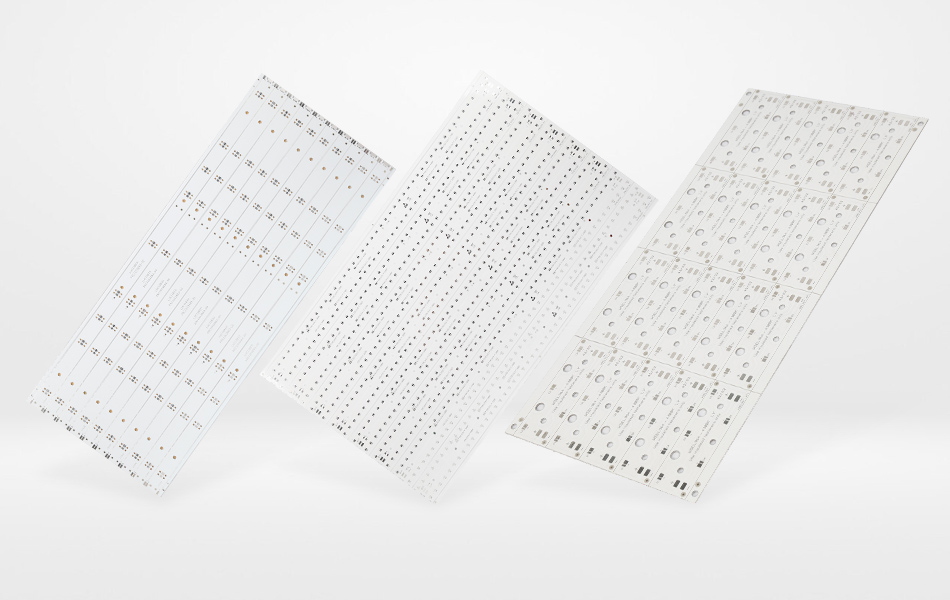
Manufacturing Processes for Aluminum PCBs
Substrate Preparation
Material Cutting: Aluminum substrates are precision - cut using CNC milling or laser cutting to achieve exact dimensions. Surface treatment processes, such as degreasing and micro - etching, enhance the adhesion of dielectric layers, ensuring a strong bond and efficient heat transfer.
Layer Lamination
Dielectric Bonding: High - pressure lamination (100–150°C, 50–100 psi) is used to bond the dielectric layer to the aluminum substrate, creating a void - free interface that is critical for maintaining thermal conductivity. This process ensures that the dielectric layer adheres uniformly, preventing delamination and heat transfer inefficiencies.
Copper Layer Fabrication
Foil Lamination: Electrolytic copper foil is bonded to both sides of the dielectric - coated substrate using thermoset adhesives, providing a smooth surface for circuit pattern transfer.
Photolithography and Etching: Circuit designs are transferred onto the copper foil using photoresist exposure, with unwanted copper etched away to form the desired traces. Laser direct imaging (LDI) is increasingly used for fine - pitch applications, offering higher precision and reduced design cycles.
Via and Hole Formation
Drilling: Mechanical drilling is used for standard vias and mounting holes, while laser drilling is employed for microvias (≤0.3mm), essential for high - density component placement in advanced designs.
Plating: Vias are plated with copper to ensure electrical connectivity between layers, with the plating thickness optimized to balance thermal and electrical performance.
Surface Finishing and Assembly
Surface Treatment: Automated lines apply surface finishes such as ENIG, OSP, or HASL, followed by flux removal and cleaning to ensure optimal solderability.
Component Assembly: Pick - and - place machines accurately mount surface - mount components, while through - hole components are soldered using wave soldering. Reflow soldering is used for surface - mount devices, creating strong mechanical and electrical connections.
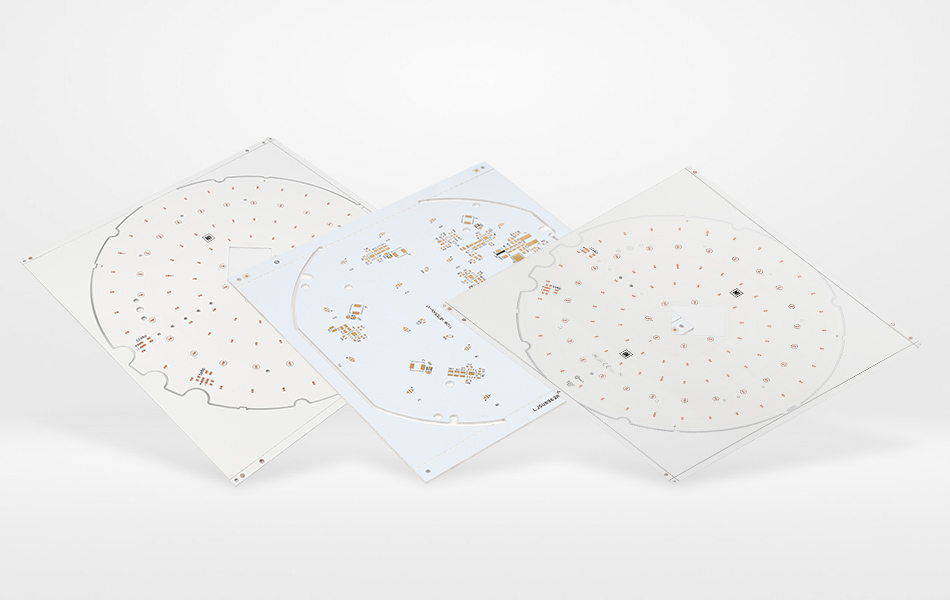
Quality Assurance: Ensuring Reliability
Incoming Material Inspection
Substrate Testing: Aluminum substrates are inspected for flatness, alloy composition, and thermal conductivity to ensure they meet the required specifications. Copper foil is checked for thickness uniformity, surface roughness, and defects that could impact electrical performance.
Component Verification: Dielectric materials and electronic components are tested for electrical insulation, thermal properties, and functionality before being approved for use.
In - Process Quality Control
Automated Optical Inspection (AOI): Systems are used to verify trace widths, via alignment, and solder joint quality during the manufacturing process, detecting defects such as open circuits, shorts, or misaligned components.
X - Ray Inspection: Used to detect voids in lamination or plating inconsistencies, ensuring the structural integrity of the PCB layers.
Final Performance Testing
Electrical Testing: Continuity tests ensure there are no open circuits or shorts, while impedance analyzers verify the characteristics of signal traces. High - voltage tests (500V DC) check the dielectric integrity between copper layers and the substrate.
Thermal Testing: Infrared thermography maps temperature distribution under load to identify hotspots, while thermal cycling tests (-40°C to +85°C) evaluate the durability of solder joints and substrate stability over repeated temperature variations.
Mechanical Testing: Vibration tests (10–2000Hz) and bend radius measurements ensure the PCB can withstand operational stresses without trace cracking or substrate damage.
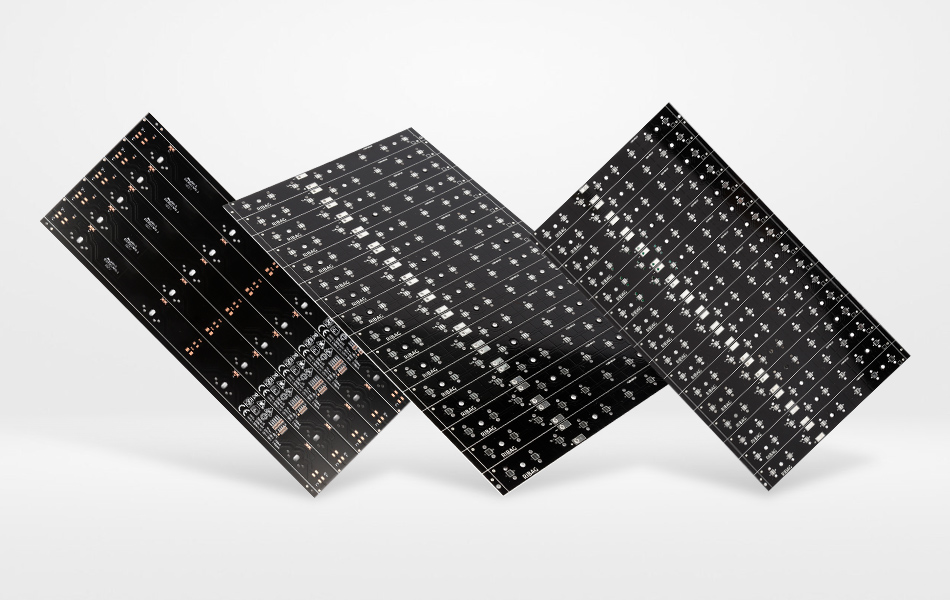
Diverse Applications of Aluminum PCBs
LED Lighting: Illuminating the Future
Aluminum PCBs are the backbone of modern LED lighting systems:
Commercial and Residential Lighting: In LED panels and downlights, they efficiently dissipate heat from dense LED arrays, ensuring uniform light output and a longer lifespan compared to traditional PCBs. Their formability allows for custom shapes in architectural lighting, enabling sleek, recessed, or curved fixtures.
Automotive Lighting: Used in headlights and taillights, aluminum PCBs manage heat from high - power LEDs and withstand the vibrations and temperature fluctuations of the engine bay, ensuring reliable operation and enhanced safety.
Automotive Electronics: Powering Advanced Systems
Engine Control Units (ECUs): Exposed to extreme temperatures and vibrations, aluminum PCBs provide a stable platform for microprocessors and sensors. Their thermal management capabilities prevent overheating, while HASL finishes resist oil and coolant exposure, ensuring long - term reliability.
Advanced Driver - Assistance Systems (ADAS): High - speed signal routing on aluminum PCBs supports cameras, radar, and lidar modules, with the substrate dissipating heat from image processors and maintaining signal integrity in high - speed data transmission.
Industrial Electronics: Withstanding Harsh Environments
Motor Drives and Inverters: Aluminum PCBs handle the high currents and heat generated by power semiconductors, ensuring efficient operation in industrial machinery. Their mechanical strength makes them suitable for applications with constant vibrations, such as conveyor systems or manufacturing equipment.
Control Panels and Sensors: In harsh industrial environments with dust, moisture, or chemical exposure, aluminum PCBs with conformal coatings provide reliable performance, supporting the automation and monitoring systems essential for modern factories.
Consumer Electronics: Enabling Miniaturization
Portable Devices: Laptops, tablets, and gaming consoles use thin aluminum PCBs to manage heat from multi - core processors, enabling slim designs without compromising performance. Their lightweight nature is ideal for portable electronics where weight and battery life are critical.
Wearable Tech: Smartwatches and fitness trackers rely on aluminum PCBs for their compact size and thermal efficiency, preventing overheating during continuous use and ensuring the longevity of wearable devices.
Aerospace and Defense: Critical Mission Applications
Avionics Systems: Aluminum PCBs are used in aircraft navigation and communication systems, where they must withstand extreme temperatures, high altitude pressures, and vibrations. Their high thermal conductivity and mechanical strength are essential for maintaining mission - critical operations.
Military Electronics: In rugged defense applications, such as missile systems and radar arrays, aluminum PCBs provide reliable performance in harsh environments, combining thermal management with resistance to shock and electromagnetic interference.
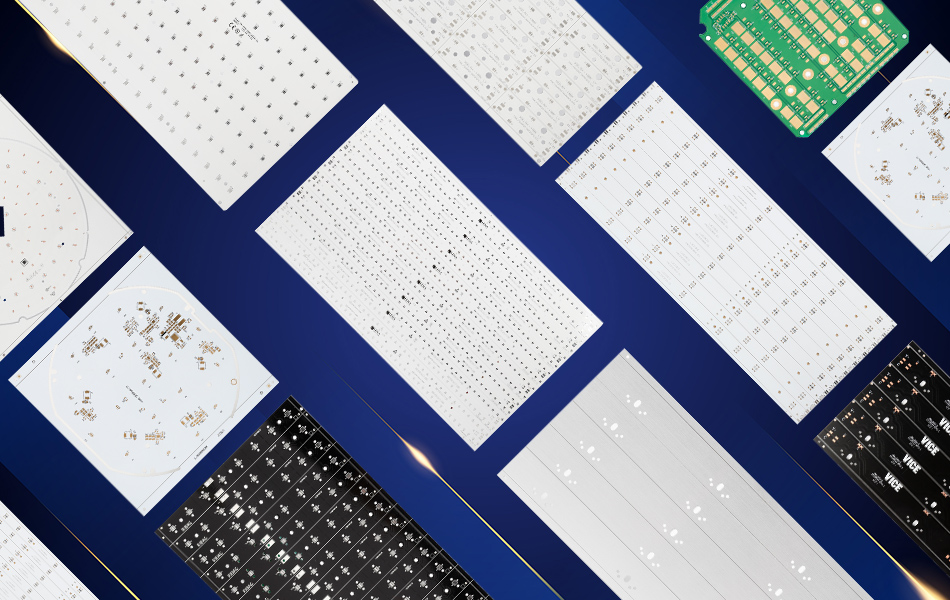
Emerging Trends in Aluminum PCB Technology
Miniaturization and High - Density Integration
Advances in manufacturing technologies, such as laser - drilled microvias, high - density interconnect (HDI) technology, and fine - pitch trace routing, are enabling aluminum PCBs to accommodate smaller components and more complex circuits. This trend is driving their adoption in IoT sensors, compact industrial controllers, and 5G communication modules, where space is limited but performance demands are high.
Sustainable Manufacturing Practices
Eco - Friendly Materials: The industry is moving towards recycled aluminum substrates and water - based dielectric adhesives to reduce environmental impact. Lead - free surface finishes and energy - efficient manufacturing processes, such as low - temperature lamination, are becoming standard to meet global sustainability standards like RoHS and REACH.
Waste Reduction: Automated processes and precise material cutting minimize waste generation, while recycling programs for end - of - life PCBs ensure that aluminum and other materials are reused, reducing the environmental footprint.
Advanced Thermal Solutions Integration
Hybrid Substrates: Combining aluminum with high - thermal - conductivity materials like graphite or carbon fiber layers creates hybrid PCBs with thermal conductivity exceeding 300 W/mK. These are ideal for high - power density applications such as 5G small cells and high - performance computing modules, where efficient heat dissipation is critical for maintaining signal integrity and component reliability.
Active Cooling Integration: Embedded micro - channel cooling systems within aluminum substrates provide liquid - cooled solutions for extreme power applications, such as server rack power supplies and electric vehicle inverters. These systems enhance heat dissipation beyond passive methods, enabling higher power densities in compact designs.
Automation and Industry 4.0
AI - Driven Design Tools: Machine learning algorithms are being used to optimize thermal via placement, trace routing, and component layout, reducing design time by up to 30% and improving overall performance. These tools can analyze thermal and electrical data to create more efficient and reliable PCB designs.
Robotic Assembly: Automated robotic lines with real - time quality monitoring ensure consistent manufacturing for high - volume applications, such as automotive and consumer electronics. This reduces human error and enhances production efficiency, critical for meeting the demands of mass - market products.
Conclusion
Aluminum PCBs have revolutionized the electronics industry by addressing the core challenges of thermal management, mechanical durability, and design flexibility in a cost - effective manner. Their versatility makes them indispensable across a wide range of applications, from everyday consumer devices to critical aerospace systems. As technology continues to advance towards smaller, more powerful, and more sustainable electronics, aluminum PCBs will play an increasingly important role. Ongoing innovations in materials, manufacturing, and thermal solutions ensure that they remain at the forefront of electronic design, enabling the next generation of devices to operate efficiently and reliably in even the most demanding environments. For engineers and designers, understanding the capabilities and potential of aluminum PCBs is essential for creating innovative, high - performance electronic systems that meet the evolving needs of the modern world.

Got project ready to assembly? Contact us: info@apollopcb.com



We're not around but we still want to hear from you! Leave us a note:

Leave Message to APOLLOPCB
